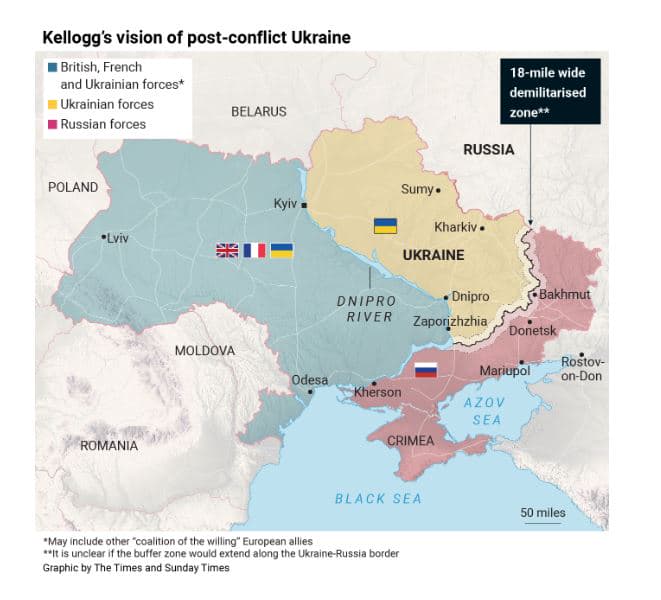Ukraine could be divided into zones of allied responsibility like postwar Berlin – Kellogg to The Times
Keith Kellogg, US President Donald Trump's Special Envoy for Ukraine and Russia, has stated in an interview with The Times that Ukraine could be divided under a peace agreement "almost like Berlin after World War Two". Source: Kellogg in an interview with The Times Quote: "You could almost make it look like what happened with Berlin after World War Two, when you had a Russian zone, a French zone and a British zone."
Advertisement:
Details: Meanwhile, Kellogg suggested that British and French troops could take control of zones in the country's west as part of a "reassurance force", while the Russian army would be in the occupied east.
Between them would be Ukrainian troops and a demilitarised zone. He believes that Anglo-French forces west of the Dnipro River, which runs through Ukraine from north to south and passes through Kyiv, would "not be provocative at all" to Moscow. He believes Ukraine is a large enough country to host forces seeking to enforce a peace agreement.
However, the US itself would not provide its own troops.
Advertisement:He suggested that an 18-mile demilitarised zone could be introduced along the existing lines of control in the east. Kellogg admitted that Putin may not accept the proposal regarding zones of control. To ensure that Anglo-French and Ukrainian forces, supported by troops from other "coalitions of the willing", would not exchange fire with the Russians, Kellogg said that a buffer zone must be established between the Ukrainian and Russian lines.
"You look at a map and you create, for lack of a better term, a demilitarised zone [DMZ]. Take both sides back up 15 kilometres each, that's 18 miles," he explained. Updated: After the article had been published, Kellogg wrote on X (Twitter) that the article distorted his words about the possible division of Ukraine.
The Times article misrepresents what I said.
I was speaking of a post-cease fire resiliency force in support of Ukraine's sovereignty. In discussions of partitioning, I was referencing areas or zones of responsibility for an allied force (without US troops). I was NOT referring... https://t.co/wFBcEVjxtO
-- Keith Kellogg (@generalkellogg) April 11, 2025"The Times article misrepresents what I said.
I was speaking of a post-cease fire resiliency force in support of Ukraine's sovereignty. In discussions of partitioning, I was referencing areas or zones of responsibility for an allied force (without US troops). I was NOT referring to a partitioning of Ukraine," he said.
Background:
- US President Donald Trump, who has promised a quick ceasefire in Ukraine, has been increasingly expressing dissatisfaction with Moscow's actions in recent days.
- In particular, he said he was "very angry" after Kremlin leader Vladimir Putin questioned the legitimacy of President Volodymyr Zelenskyy and was outraged by Russian attacks against Ukrainian cities.
- Meanwhile, media reports suggested that senior Trump administration officials have begun to acknowledge that the US may not be able to reach a peace deal on Ukraine in the next few months due to additional conditions imposed by Moscow during negotiations.
- At present, Trump has urged Russia to take steps to end its full-scale war against Ukraine.
- On 11 April, Steve Witkoff, US President Donald Trump's Special Envoy to the Middle East, and Russian leader Vladimir Putin held talks regarding the cessation of Russian aggression in Ukraine.
Support Ukrainska Pravda on Patreon!